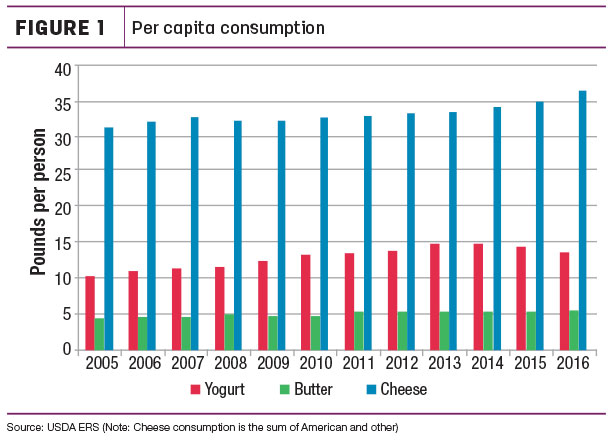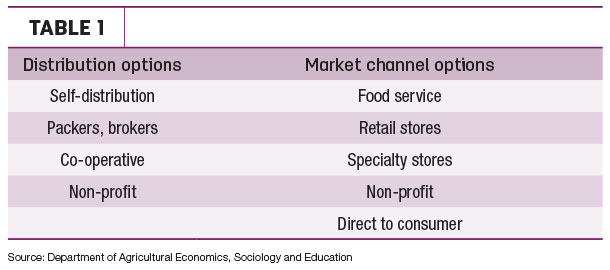A 2017 Penn State Extension survey revealed four primary motivators for starting a value-added enterprise – maintaining a small family operation, improving profitability, having an interest or passion for processed dairy products, or providing a business opportunity for current and future generations.
While launching a value-added dairy enterprise can be an appealing strategy to achieve one or more of these goals, it requires significant planning.
In the same survey, marketing was identified as the second-most challenging aspect of operating an artisan or farmstead dairy processing enterprise (edged out only by knowledge and fulfillment of government regulations). Marketing is the cornerstone of all successful businesses, and farmstead dairy processors must stay up-to-date on marketing factors, including consumer trends, the competition, market outlets and pricing.
Successful marketing is built upon a solid marketing strategy. Your marketing strategy is the product of your marketing research and marketing mix. Market research includes understanding how the industry is performing and changing as well as your potential consumers or target market.
Keep in mind your target market may be end users (consumers) or intermediate buyers. If you’re marketing to intermediate buyers, such as restaurants, you not only need to understand them but also the customers they serve.
Without a well-identified and receptive target market, a value-added enterprise is likely to struggle. Knowing who will be interested in your products requires an understanding of people’s location, values, needs, behaviors and economic status. Ensure you can identify a customer base that will purchase your product prior to beginning production.
A broad view of the dairy landscape shows consumption of dairy products is on the increase (Figure 1).

Per-capita consumption of butter, cheese and yogurt in the U.S. has steadily increased over the past 10 years. And while fluid milk consumption has decreased, flavored milk sales are on the rise. Also keep in mind there are multiple varieties of dairy products (for example spoonable versus drinkable yogurt), so delving beyond the initial layer of data is important.
By definition, value-added requires you differentiate your product from others available to the consumer. Your marketing mix, also referred to as the four P’s (product, place, price and promotion) can do this for you. Let’s take a look at each “P.”
Product
The key to your marketing mix is your product. Your product is a bundle of characteristics – quality, features, brand name, packaging and design, and product-related services you may provide the customer, such as recipes or pairings. Taste is probably the most important element of your product to consumers and can be more important than price when they make a purchase decision.
Every product has a life cycle. Beginning with its introduction, a product moves into an early growth stage, followed by maturity and finally decline (and perhaps exit). Therefore, product innovation is essential. The easiest example to illustrate this is flavors.
Consider the number of different-flavored cheddar cheeses – habañero, tomato basil, garlic and herb, Buffalo wing – the list goes on. Food trends change, and you want to be prepared to move with them. That pumpkin pie-flavored Gouda might be unique, but if it’s not selling, and customers are asking about cheeses flavored with Indian spices, you need to reconsider what you’re making.
Your target market will also influence your product mix – the number and types of products you make and sell. Using cheese as an example, a farmstead processor making several types of cheese – for instance, cheddar, Gouda, brie, havarti – has breadth to their product mix.
Depth is achieved if you offer several selections – flavor, size, form – within a product type. A business that offers both depth and breadth in its products has increased pricing options.
A final aspect related to product is the quantity you produce. Coordination of supply with demand is essential. You need to meet demand for your product while not over-producing. While some dairy products, such as some types of cheese, can be stored until it can be sold, you will have already incurred the expenses for producing and storing it.
Other dairy products have more limited shelf lives, necessitating calculated planning of production quantities.
Place
How and where will the product be marketed? Direct-to-consumer marketing outlets include on-farm markets, farmers’ markets, online stores, Community Supported Agriculture programs and home delivery. Wholesale markets include grocery stores, specialty shops or restaurants. Distribution options or requirements also need to be taken into account when considering the market outlets available (Table 1).

Smaller, direct-to-consumer markets are often an attractive first option while you refine production processes, hone product recipes and work up to full capacity. Starting in smaller markets offers the advantage of being able to gather customer feedback on products.
Having thoroughly researched your target customer market will also assist you in determining the most effective market outlets for your product. For instance, market research company Mintel reported in their 2016 cheese report younger consumers, age 18 to 34, had a higher rate of purchasing cheese from non-traditional locations such as farmers’ markets and online supermarkets (e.g., PeaPod, Amazon Fresh).
Fourteen percent of consumers in this age group purchased cheese from a farmers’ market, compared to only 4 percent of consumers over age 55.
Price
Setting prices for your products is both an art and a science. Most importantly, you must know and understand your cost of production. From there you can adjust based on product characteristics, a specific pricing strategy, customer price sensitivity, customer values and other factors.
Price contributes to the perception of your product; that is, when consumers see a product price, it sends signals to them about quality, match with the market outlet, expectations for assistance, etc. Keeping accurate and complete records accounting for all steps – production, packaging, storage, promotion, transportation/distribution and sales – will assist you in setting a price and making adjustments as necessary.
Promotion
Promotion is the final piece to the marketing puzzle. How will you let your target market know that you have a product they want? Promotion goes beyond just advertising: think about social media engagement, community involvement, customer service, hosting special events and more.
One promotional tactic is sampling, something 51 percent of cheese consumers say is important to do before purchasing. If the product is going to be marketed directly from the farm, another aspect to consider is the overall appearance and presentation of the farm along with the location.
A value-added dairy processing enterprise can be rewarding and profitable with advance planning. By spending time on research and planning a marketing strategy, you’ll be well positioned to achieve your goals. ![]()

-
Sarah Cornelisse
- Senior Extension Associate
- Department of Agricultural Economics, Sociology and Education
- Penn State University
- Email Sarah Cornelisse






